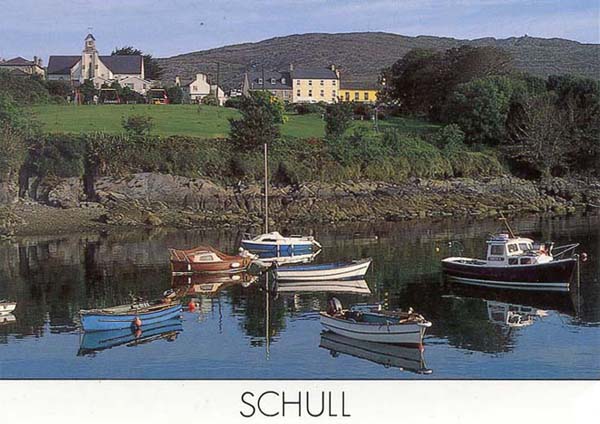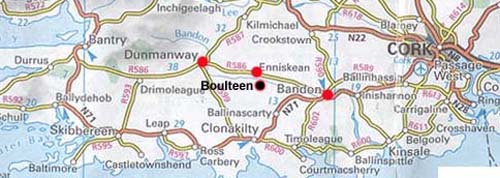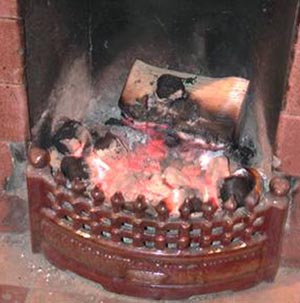
On January 4,1997, my grandmother, Ksenia Mienscow (Menshov) Haller, passed away at the age of 97. I flew from Seattle to Boston to attend her funeral and to help my mother sort through her belongings. While I was there, I came across family photographs that my grandmother had saved. Some of them dated back to before she and her family emigrated from Russian Poland in 1909.
These photographs sparked in me a curiosity about my roots, and I found myself asking the age-old question, “Where did I come from?” For some reason, at that time, I was more interested in learning about the Irish side of my family. When I asked my parents about our Irish side of the family, however, they had very little information.
All they knew was that the family came from County Cork, Ireland, that my father’s grandfather’s name had been Robert Swanton, that he had married Rosanna Hanlon, and that he had been a carpenter. His daughter, my great-aunt Mary Swanton Pinkham told me that her father never talked about his life in Ireland, and all he would say was that he was born "by the bridge".
This wasn’t much to go on, and I had no idea where or how to begin my research. I discovered the LDS Family History Centers, and looked up the Swanton surname in their International Genealogy Index. To my surprise, I found quite a few there, and just about all the Swantons in Ireland were from County Cork. In the IGI, the origin of many of the Swantons was recorded as the Skull Dispensary, which struck me as a very strange name.
I later learned that Skull was also known as Schull, and was a pretty little town on the water in West Cork, and that a dispensary was the local equivalent of a hospital or lying-in place for expectant mothers. However, when I first saw the term, Skull Dispensary, I had a mental image of tiny little heads with bodies attached to them being dispensed like Pez candies! I was very new at this, and all these Irish names sounded strange to me.

I learned about the Griffith’s Valuation, a land valuation that was taken in Cork in 1852, and I pored through the microfilms of it looking for Swantons. I bought a detailed map of County Cork, which showed all the townlands in the area where most of the Swantons had lived. On this map, I highlighted all the townlands where the Swanton name had appeared in the Griffith’s Valuation.
I was still no closer, though, to learning about my Swanton family. I decided to follow the advice given to me by many seasoned researchers, and started to work backwards, finding as much information as possible about my family in Boston.
Luckily, I live only thirty minutes from the Pacific Northwest National Archives in Seattle, Washington. I quickly learned about Soundex indexing systems, and eagerly delved into the Boston census records. My biggest thrill was finding my first census record for my great grandfather and his family. This was my first tangible indication that these people were actually real! I soon found more census records, but each contained conflicting information about dates of birth and immigration. However, at least I had a general idea of when my great-grandfather had been born.
I learned that civil registration for births, marriages and deaths in Ireland had become mandatory in 1864, and that the indices for these records had been microfilmed by the LDS (Mormons) and were available through their Family History Centers. I ordered the birth indices for the range of years in which I had calculated that Robert had been born and waited about three weeks to receive them. Finally I received a call from my local Family History Center telling me that my microfilms had arrived. These indices provided the volume and page number for the actual records. I noted all the likely candidates, and then ordered more microfilms for the records themselves and waited another three weeks. I was having fun—this was like a treasure hunt!
The microfilms finally arrived, and it was very exciting to see copies of the actual handwritten records from the late 1800’s. There were a number of Robert Swantons born between 1864-1868, though, and I still had no idea which one was my Robert Swanton.
My next step was to look through the Massachusetts death indices to see if I could find him there. Once I found an index entry that looked like it might be the Robert Swanton I was looking for, I sent to Massachusetts for his death certificate. Success at last! The death certificate showed that this Robert Swanton’s wife had been Rosanna Hanlon, which coincided with the information my parents had given me about my great grandfather. It also gave the names of his parents, who were Michael Swanton and Elizabeth Bradfield.
Sure enough, one of the Irish civil birth records I had found was for a Robert Swanton, born in County Cork on April 24, 1865, who had these same parents. I had finally found my Robert Swanton! This record also contained an additional piece of information—the name of the townland in which the Swanton family had lived when Robert was born. The townland was Boulteen, and I found it on my map. It was northeast of Schull and south of Enniskeane.

I didn’t realize at the time how lucky I had actually been. Michael and Elizabeth (known as Bessie) had had 10 children, and Robert was the only one who had been born after 1864, which is when civil birth/death and marriage registration became mandatory. Before then, the only records available were on the parish level. If he had been born before 1864, I would probably never have been able to find out exactly where my Swanton family was from in Ireland. He was the tenth child of Michael and Bessie.
Well, the rest, as they say, is history. I progressed from an inexperienced researcher into a dedicated researcher, and since I began my research in 1997, I have amassed an immense amount of information about my Irish Swanton family.
I’ve spent hours sitting in musty archives, poring over microfilms and thumbing through old dusty tomes. I discovered the Family History Library in Salt Lake City, and I looked up many birth, death and marriage records for Swantons in Ireland. I also saw for the first time, the incredible book entitled “The Swanton Family History Worldwide”, which had been written by Louise May Swanton in 1979. Although there was only one mention of my Swanton line in the book (Robert Swanton’s birth), there was an amazing amount of Swanton information in it, going back to 1242 in England. Coincidentally, my interest in my Swanton roots began about a month after Louise May Swanton’s death. I like to think that she somehow passed the Swanton research torch on to me.
I traveled back to Boston, where I visited the homes in which my my ancestors had lived in South Boston and Dorchester. I wandered through cemeteries looking for their graves. I visited the Massachusetts Archives, the National Archives, the Catholic Archdiocesan Archives, and the Suffolk County Probate Court. Little by little, I was starting to discover more information about Robert and some of his brothers and sisters.
In 1998, I went to Ireland, where I had the opportunity to look through the Catholic parish registers of the Church of the Immaculate Conception in Enniskeane. These records included the records for the united parishes of Enniskeane, Desertserges and Kinneigh.
I started with the first parish register in Enniskeane, which dated back to 1813. It was truly an amazing experience to actually handle these books, very carefully, of course, and to see the original records. The first Swanton record I found was for 1817. Unfortunately, it was very hard to read, and the mother’s name was illegible. I found the baptismal records for nine of Michael and Bessie’s children, as well as many confirmation and marriage records. I typed every Swanton and Bradfield record I found into my laptop computer. I also took digital and film photos of these records.
I spent so much time going through the records that Father Sean McCarthy finally just gave me the key to the church. As I pored over the church registers, it was easy to lose track of time. I would stay in the sacristy until about 10 or 11 at night. The later it got, the louder the creaks and groans of the old building became, and finally I’d lock everything up and leave. I’d walk outside in the pitch black, past the cemetery, to Maura Murray’s house.
Maura and her husband, Paddy Murray, helped out at the church, and they were the keepers of the church key. I spent many wonderful evenings with Maura, sipping tea in front of her cozy coal fire, and giggling about how creepy the church and the cemetery were at night.

In one of those ironic twists of fate, Paddy Murray told me that his mother had been Anne Swanton from Lissicorrane. In the course of my research, I later discovered that Paddy Murray is my third cousin, once removed.
I hired a research firm in Ireland to go through the Catholic parish records for the areas in which I knew Swantons had lived. I went back to Boston, and found a treasure trove of information in the probate records.
These probate records were the most informative and rewarding records I have found in my research. Instead of simply providing dates and names, they provided details of my ancestors’ lives, which truly brought them alive for me.
I’m still uncovering new records, but I decided that at some point, I needed to organize all the bits and pieces of information I had acquired and just sit down and start writing. I hope you enjoy reading this family history as much as I enjoyed researching and writing it.
Ginni Swanton
May 14, 2004
Seattle, Washington